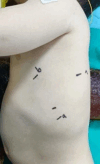Effect analysis of flexible bronchoscopy in thoracoscopic surgery for congenital pulmonary airway malformation
- PMID: 40760621
- PMCID: PMC12323994
- DOI: 10.1097/MD.0000000000043635
Effect analysis of flexible bronchoscopy in thoracoscopic surgery for congenital pulmonary airway malformation
Abstract
The objective of this study is to investigate the clinical efficacy of flexible bronchoscopy (FB) in thoracoscopic surgery for congenital pulmonary airway malformation (CPAM) in pediatric patients. We randomly divided the CPAM patients who underwent thoracoscopic surgery at our hospital from May 2022 to January 2024 into 2 groups based on whether they received FB treatment before and after thoracoscopic surgery. Group A included 24 patients who received FB treatment, while Group B consisted of 21 patients who underwent conventional thoracoscopic surgery. We performed a comparative analysis of the clinical data between the 2 groups. All patients successfully underwent thoracoscopic surgery and were followed up for at least 3 months. The postoperative atelectasis rate in Group A (0%) was significantly lower than that in Group B (28.6%), with a statistically significant difference (P = .018). There was no statistically significant difference in other postoperative complications, and no severe postoperative complications occurred in either group. The chest drainage time, total drainage volume, postoperative inflammatory markers, and postoperative hospitalization time in Group A were all significantly lower than those in Group B (P = .000, P = .014, P = .001, P = .022, P = .006, P = .001). No significant differences were observed in gender, age, or prenatal diagnosis rate between the 2 groups. Additionally, there were no significant differences in surgical methods, operation time, intraoperative blood loss, or postoperative ventilator use between the 2 groups. The application of FB in thoracoscopic surgery for CPAM is both effective and feasible. It can effectively alleviate postoperative inflammatory reactions, reduce drainage volume, shorten postoperative hospital stays, and prevent postoperative atelectasis.
Keywords: congenital pulmonary airway malformation; flexible bronchoscopy; lobectomy; segmentectomy.
Copyright © 2025 the Author(s). Published by Wolters Kluwer Health, Inc.
Conflict of interest statement
The authors have no funding and conflicts of interest to disclose.
Figures










Similar articles
-
Thoracoscopic lobectomy for congenital pulmonary airway malformations before or after 5 months of age: evaluation of pulmonary function.Minerva Pediatr (Torino). 2025 Aug;77(4):288-293. doi: 10.23736/S2724-5276.23.07124-0. Epub 2023 May 22. Minerva Pediatr (Torino). 2025. PMID: 37212683
-
Efficacy analysis of fiberoptic bronchoscopy combined with thoracoscopy in the treatment of mediastinal bronchogenic cysts in children.Medicine (Baltimore). 2025 Aug 15;104(33):e43994. doi: 10.1097/MD.0000000000043994. Medicine (Baltimore). 2025. PMID: 40826738 Free PMC article.
-
Bronchoscopy-guided antimicrobial therapy for cystic fibrosis.Cochrane Database Syst Rev. 2024 May 3;5(5):CD009530. doi: 10.1002/14651858.CD009530.pub5. Cochrane Database Syst Rev. 2024. PMID: 38700027 Free PMC article.
-
Conventional chest physiotherapy compared to other airway clearance techniques for cystic fibrosis.Cochrane Database Syst Rev. 2023 May 5;5(5):CD002011. doi: 10.1002/14651858.CD002011.pub3. Cochrane Database Syst Rev. 2023. PMID: 37144842 Free PMC article.
-
Morphological, functional and neurological outcomes of craniectomy versus cranial vault remodeling for isolated nonsyndromic synostosis of the sagittal suture: a systematic review.JBI Database System Rev Implement Rep. 2015 Sep;13(9):309-68. doi: 10.11124/jbisrir-2015-2470. JBI Database System Rev Implement Rep. 2015. PMID: 26470674
References
-
- Wong KKY, Flake AW, Tibboel D, Rottier RJ, Tam PKH. Congenital pulmonary airway malformation: advances and controversies. Lancet Child Adolesc Health. 2018;2:290–7. - PubMed
-
- Lau CT, Kan A, Shek N, Tam P, Wong KK. Is congenital pulmonary airway malformation really a rare disease? Result of a prospective registry with universal antenatal screening program. Pediatr Surg Int. 2017;33:105–8. - PubMed
Publication types
MeSH terms
LinkOut - more resources
Full Text Sources

